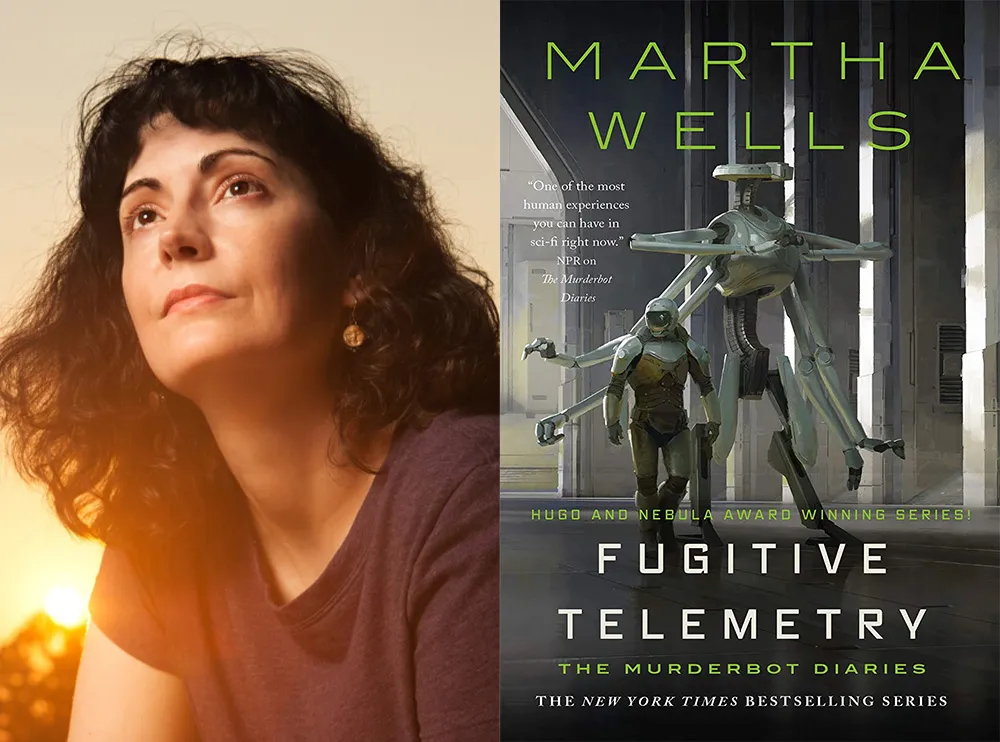There are only a few fundamental points to understand about Fugitive Telemetry including the author, the narrator, the location, and an important supporting character; nothing else is extraordinary about it yet it’s an entirely good read.

Martha Wells
First, the author. Martha Wells has been an author, primarily speculative fiction, since the early 1990s. Her books were never really massive hits, but successful enough to keep her name in the publication circle and bookstores nationwide. Things started to look even more barren by the mid-2000s following the lack of fanfare in the release of the final book in The Fall of Ile-Rien trilogy. Wells herself thought it was time for her to quietly fade away into obscurity. She just couldn’t sell another book and her career went down rather quickly.
But Wells decided to give it another shot, acquired a new agent, started a new series, and worked with a new publisher. Some of her most popular works at this point were Magic: The Gathering’s Dominaria (as head writer of the story) and the Star Wars novel Empire and Rebellion: Razor’s Edge. The works were not exactly unknown, but at the same time not popular enough for a fiction author to win any award or climb up the ladder of fame.
And then Murderbot hit the shelves. The first of the series is titled All Systems Red; an introduction to an ongoing series about a heavily armed combat-ready cyborg security agent whose favorite activity is watching soap operas. Published in May 2017, All Systems Red won the subsequent year’s Nebula and Hugo Awards for Best Novella category.
Murderbot – A Construct
Second, the narrator. Despite the horror-inducing name, Murderbot isn’t actually dangerous, except for one time when it malfunctioned and ended up killing 57 people. Originally one of the Security Units created by a corporation known simply as the “The Company,” Murderbot is a construct, an autonomous, genderless, and sentient being built from a combination of organic tissues (usually human clones) and inorganic robotic components. There are countless other constructs, but Murderbot is a peculiarity in the sense that it has hacked itself to be more human but it despises humans in general. The only exception is Dr Mensah, who frees Murderbot from The Company’s contract and allows it to live autonomously in Preservation Station, part of the Preservation Alliance in which she serves as the planetary leader.
The Story
Preservation Station brings us closer to Fugitive Telemetry. Now that Murderbot resides in the station, there wouldn’t be many services required of it. The station is quite possibly one of the safest locations in the series’ known universe, with barely any crime rate apart from some inconsequential petty misdemeanors and plain stupidity.
Recently, however, a human body has been discovered. All signs point to the possibility of a serious homicide investigation. While the station has its own security agency, all the human officers are grossly inexperienced in handling any sort of felony, especially murder. Dr Mensah is aware of the officers’ shortcomings, and therefore she asks Murderbot to take part in the detective work, much to the discontent of the human security team, led by Senior Officer Indah.
Dr Mensah is Murderbot’s favorite human—perhaps the only human it likes and respects anywhere. It will not decline the request. The problem is that Preservation Station is unlike any other place where Murderbot (and other constructs for that matter) has been assigned to do any investigative effort before. It can hack security systems and access confidential personal data to conclude the case quickly, but the station will not allow such a blatant breach of privacy. Furthermore, Murderbot cannot simply eliminate possible suspects by killing them. There are rules to obey. To make things more complicated, the surveillance system in the station is inadequate for civil rights reasons.
The investigation dynamics among the human characters and Murderbot are the high points of the novella. Bear in mind that Murderbot itself is part human and part robot; the “human side” of it wants to collaborate with the security team, in contrast to the robotic brain that struggles to put aside its hatred toward humans. Murderbot has many reasons to dislike the station security (incompetence is only one of them) and the human team doesn’t trust it either. At least in the mind of the security team, there is always the risk of Murderbot killing people once it has been granted full access to the system.
Much of the investigative effort runs like a typical episode of a police procedural TV show. Once a dead body is discovered, the entire Preservation Station is in lockdown and no one is allowed to go out of town. After going through an old-fashioned forensic examination and discovering the victim’s identity, room, travel schedules, and location history, Murderbot is able to locate a troubled transport where it discovers and takes several hostiles into custody. Later on, the hostiles claim to be part of the refugee network to help slaves escape from a mining planet.
Senior Officer Indah becomes more appreciative and allows Murderbot to access the security system. The victim turned out to be part of the network and was killed by a bounty hunter. A strange incident as observed in a surveillance system indicates that the footage has been maliciously altered by an internal party.
As far as the story goes, there is nothing really new about Fugitive Telemetry. That said, Wells has made Murderbot’s sarcastic and ridiculous takes on human perspectives truly relatable. Readers are drawn to care about it and want it to prevail. It is a short and stand-alone story, as opposed to being a chronological part of the Murderbot Diaries.
Have you read Fugitive Telemetry or any other book in the Murderbot Diaries series? Can you relate to Murderbot’s perspectives toward humans? Let us know. We’d like to hear from you.
Other things you might want to know:
What does “Fugitive Telemetry” mean?
The term “fugitive telemetry” is a method of finding a fugitive using telemetry. But the book, simply refers to the dynamics of an investigation into a murder case led by a cyborg.
What is the major theme?
Much like other books in the series, Fugitive Telemetry depicts the Murderbot as a human-robot hybrid that knows exactly what it doesn’t like or want. However, it also discovers that figuring out what it really wants can be even trickier. The cyborg’s journey into the discovery is through a murder case and the subsequent joint-investigation effort with human officers.
How does “Fugitive Telemetry” fit in with the broader narrative of the Murderbot Diaries series?
The overall atmosphere of the story revolves around the idea of Murderbot and the Preservation Station trying to get used to each other. The security department at the station is not entirely pleased with the presence of a “killing machine” in a normally safe territory. A homicide in the station leads them to work closely together, partly because the security department has no idea how to handle such a case.
Check out other articles by month:







